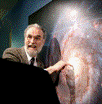Department of Physics and Astronomy: Publications and Other Research
Date of this Version
4-1-1998
Citation
Astrophysics Journal Supplement (1998) 115
Abstract
Results of a ground-based optical monitoring campaign on 3C 390.3 in 1994-1995 are presented. The broadband fluxes (B, V , R, and I), the spectrophotometric optical continuum flux Fλ(5177 Å), integrated emission-line fluxes of Hα, Hβ, Hγ, He I λ5876, and He II λ4686 all show a nearly monotonic increase with episodes of milder short-term variations superposed. The amplitude of the continuum variations increases with decreasing wavelength (4400-9000 Å). The optical continuum variations follow the variations in the ultraviolet and X-ray with time delays, measured from the centroids of the crosscorrelation functions, typically around 5 days, but with uncertainties also typically around 5 days; zero time delay between the high-energy and low-energy continuum variations cannot be ruled out. The strong optical emission lines Hα, Hβ, Hγ, He I λ5876 respond to the high-energy continuum variations with time delays typically about 20 days, with uncertainties of about 8 days. There is some evidence that He II λ4686 responds somewhat more rapidly, with a time delay of around 10 days, but again, the uncertainties are quite large (~8 days). The mean and rms spectra of the Hα and Hβ line profiles provide indications for the existence of at least three distinct components located at ±4000 and 0 km s-1 relative to the line peak. The emission-line profile variations are largest near line center.


Comments
Copyright 1998, University of Chicago. Used by permission